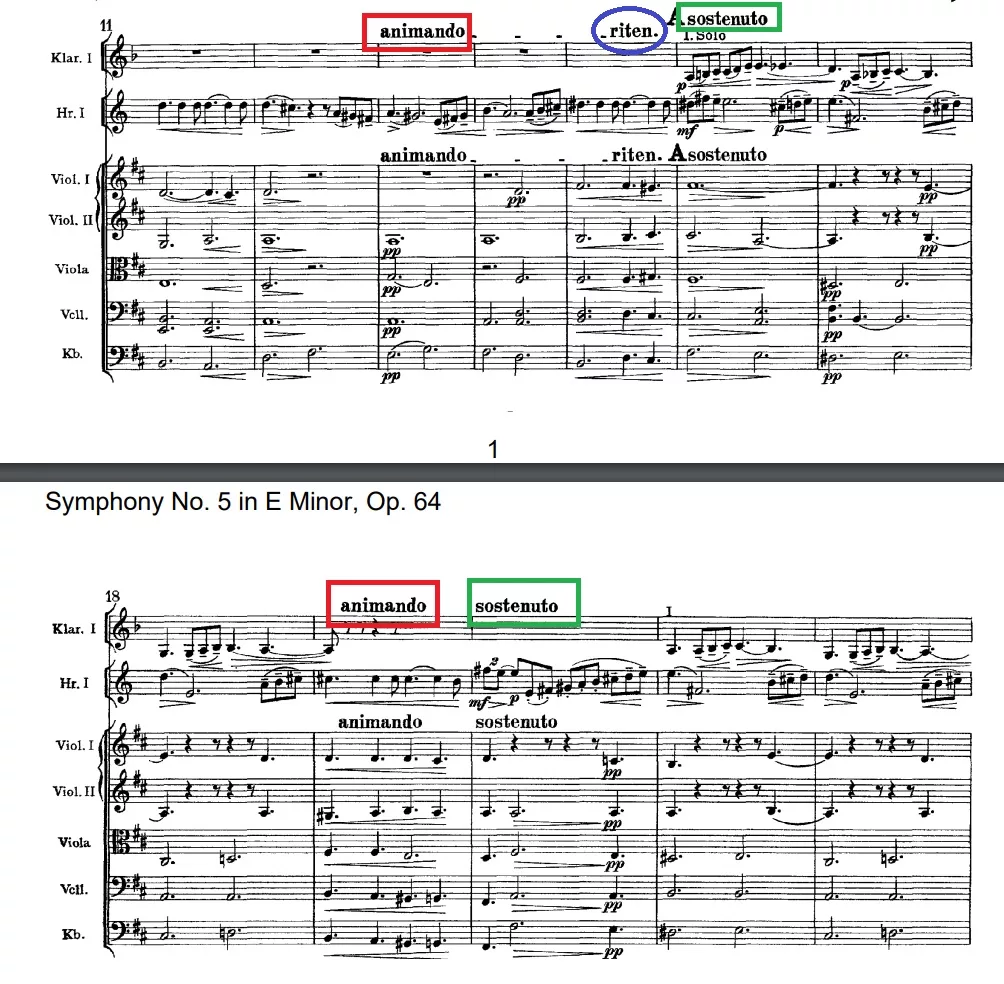In my previous post, I wrote about the BPM 54 pace is the "fundamental" of whole movement. It's not some occasional marking, but a result of careful consideration from Tchaikovsky. In this article, I would like to further discuss the topic of tempi, as well as explore the terms Tchaikovsky used here.
In this movement, sostenuto and animando are among two of the most frequently used terms and often appear as a group or pair. Sometimes, ritenuto will be the "transfer station" between those two. Therefore, before going further into the score, maybe it's better to define those terms. Sostenuto usually being understood as "played in a sustained/prolonged manner", while tenuto as "held the note in full value", ritenuto means "immediate reduction of speed". Those three are acutally in same famiily, but with the above mentioned definition, it's not so easy to get the DNA of this family. For this topic, I'll recommend a book, written by Japanese musician who lived in Italy for a long time. The name for the book is "豁然開朗!音樂術語即時通", which litterally means "Enlightened! Get through the Italien music terminology". ( I have no idea if there is a English translation or not). The author explained howmusic terms are being used in daily life in Italy. I can only briefly quote some of his explanation here. In the viewpoint of the book, "tenuto" is related to "grab, hold, keep", the power is downward; while "sostenuto", is more related to "support, uphold", more like an upward motion. And "ritenuto", the ri- is something to emphasize tenuto, which extended in meaninig as carefully hold. The "reduction of speed" is a result of carefulness.
前面提及本樂章另外一個常見的字animando,它得要與另一個外型相近的字animato一起看。前者台灣翻譯為「逐漸活躍的」,後者是「生氣蓬勃的」,這部分的翻譯我覺得相當恰當,把「轉變為另一種狀態」跟「一種狀態」在翻譯中區分得很清楚,就好比是「越開越快」是變化中的狀態,而「開車開得很快」是一種既定狀態一樣。同樣地,可以來看一下《即時通》一書中的解釋:animato是有生命力的狀態,可以指生命體,也可以形容人潮踴躍活絡、繁華的狀態,或是注入生命力。該書作者特別提及,不能看到它就單純將速度變快來處理,而是要賦予音樂靈魂與生命。而animando,字根與animato相同,但-ando的結尾就會變成是「正在成為…」的這種型態了,如果今天有一個字叫做「戀愛ando」,意思就是「戀愛ING」了。
不知不覺寫了一大串,我想現在是個好時機來看幾個柴可夫斯基應用這些術語的橋段,並且聊聊我的想法。

雖然上面的文字,解釋了animando與sostenuto 非指稱速度,所以不必然要做速度上的調配,但這裡根據前後文脈絡,個人淺見認為在速度上做變化最能達到相應的效果,因此下面會主要以速度方面討論,這裡可以觀察到的點有三:
- animando與sostenuto 經常是成雙成對地出現(但後面偶有獨立存在)
- 上半部從animando的狀態回到sostenuto 時,有透過ritenuto中介;意即,以簡化過後的技術操作而言,是漸快–漸慢–sostenuto 的速度狀態,這裡也可以理解為一種較慢的狀態,但究竟要多慢?是回到原速的慢嗎?如果是這樣,何不寫 Tempo I (初始速度)呢?這點稍後再討論。
- riten. 擺的位置十分精巧,第三拍開始慎重地慢下。與此對比,譜例下半部「沒有riten.就直接切到緩慢狀態」顯然是相當突出。
一台車一邊加速一邊行駛著,之後駕駛看到了遠方的紅燈而減速,因為車上的人都睡了,踩得特別小心謹慎,這個狀態跟一台加速中的車在最後一秒突然發現測速照相,緊急大腳踩煞車到合法的位置,想必是相當不同的兩種情境,後者更是很不符合自然情況下的運動原則。這段音樂在前後數個小節之間,有這麼多的不同,然而幾乎所有的錄音,在第二次的sostenuto 之前,都理所當然地做了跟前一次一樣感覺的減速,這是真的讀譜之後,我很訝異,也覺得很可惜的地方。
回顧一下前述的第2點,有關sostenuto究竟是不是「曲子開始時的原速」,我的答案是否定的,首先是開頭的Andante以及cantabile多多少少都帶有一點不疾不徐的流動感意象,另外更是因為作曲家用的可不是sostenuto而已,他的手稿是說molto sostenuto啊。柴可夫斯基的手稿上,使用的是更為細膩的文字變化,印刷出來的譜為何簡化不得而知,但如果照著手稿上的資訊,似乎更有了點層次。文章已經太長了,就不再闡述個人觀點,謹用跟上面同一張譜例,在旁邊按照作曲家原本寫的內容「修正術語」,閱讀到這裡的您也許也能一同細細品味這番層次。

最後,用手稿上一個小小細節,來佐證在第一張譜例時,我所提出的「第一次減速、第二次直接慢」的想法,這種小小的細節,真的非常有趣。


非常認真的文章 👏